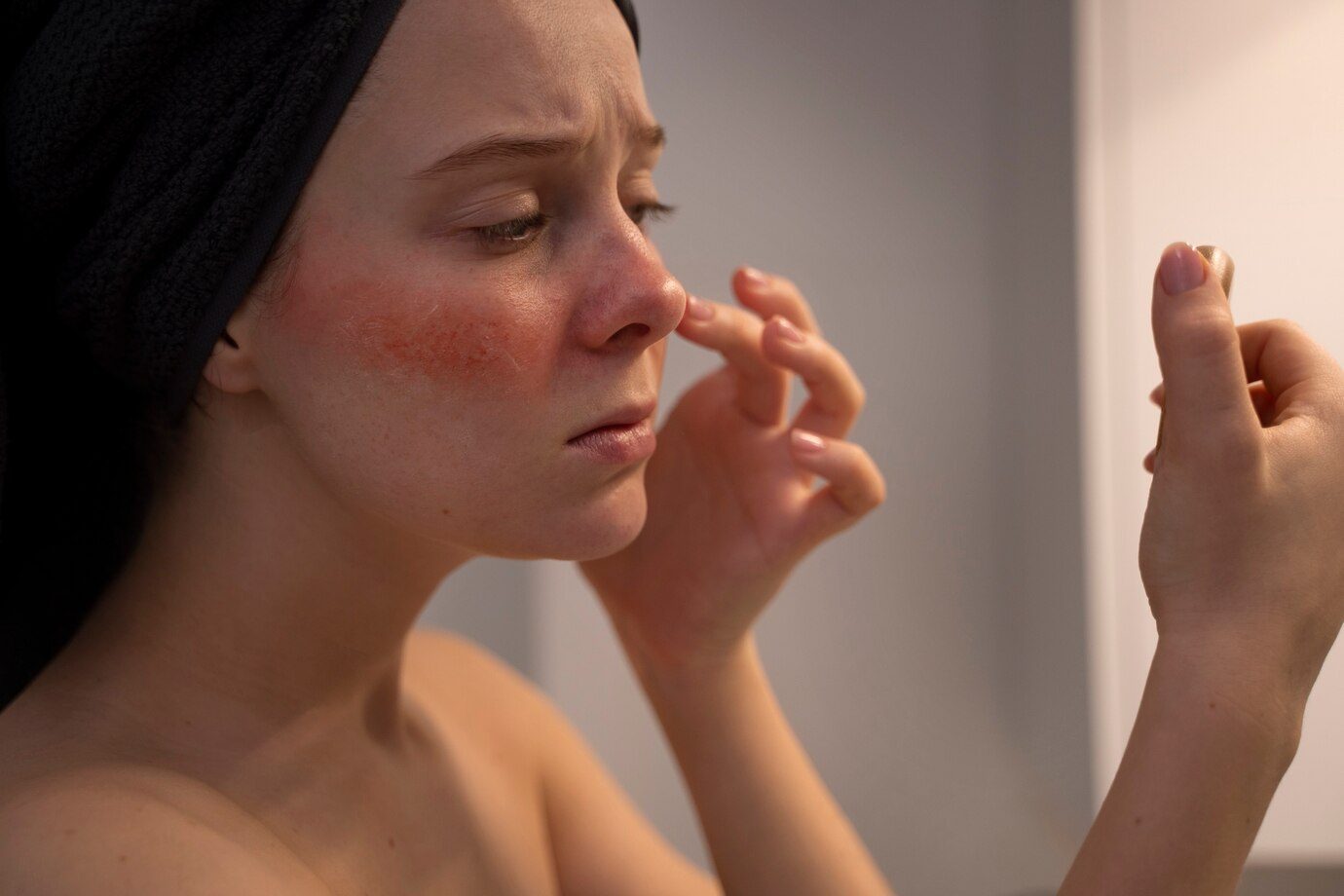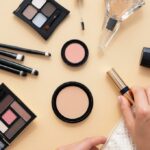Having healthy skin isn’t just about looking good—it’s about feeling good, too. Many of us deal with skin problems like pimples, dark spots, or dry patches that make us less confident. The good news is that most skin problems can be fixed with the proper care.
As a dermatologist with over 15 years of experience treating thousands of patients, I’ve seen firsthand how the correct information and treatments can transform troubled skin. My journey with hormonal acne in my twenties led me to this field, and I’m passionate about helping others find solutions that work.
We’ll look at three common skin problems—acne, dark spots, and dryness—and learn how to treat them. I’ll explain things in plain language and share tips that anyone can follow, even kids! So, let’s get started on your path to healthier, happier skin.
Understanding Your Skin
Before discussing fixing skin problems, let’s learn a bit about our skin.
Your skin is like a protective coat that keeps your body safe. It has three main layers:
- Epidermis: The outer layer you can see and touch
- Dermis: The middle layer with blood vessels, nerves, and hair follicles
- Hypodermis: The bottom layer with fat that keeps you warm
Your skin does essential jobs:
- It protects you from germs and dirt
- It helps control your body temperature
- It lets you feel things through touch
- It makes vitamin D when you’re in the sun
Your skin also has something called a “skin barrier.” Think of it like a brick wall. The “bricks” are your skin cells, and the “mortar” is made of oils and fats that hold moisture in. When this wall is strong, your skin is healthy. When it’s damaged, you can get skin problems.
Everyone’s skin is different. Some people have:
- Oily skin: Makes a lot of oil and often looks shiny
- Dry skin: Makes less oil, can feel tight or flaky
- Combination skin: Oily in some places (like the T-zone) and dry in others
- Sensitive skin: Gets red or irritated easily
Knowing your skin type helps you pick the right products. Next, look at common skin problems and how to fix them.
Acne: Causes and Solutions
What Is Acne?
Acne is more than just pimples. It happens when your hair follicles (tiny holes in your skin) get clogged with oil and dead skin cells. Bacteria can grow in these clogged pores, causing inflammation (redness and swelling).
Types of acne include:
- Whiteheads: Closed, clogged pores
- Blackheads: Open, clogged pores (the black color isn’t dirt—it’s oil that turned dark when exposed to air)
- Papules: Small, red, tender bumps
- Pustules: Papules with pus at the tip
- Nodules: Large, painful lumps under the skin
- Cysts: Deep, painful, pus-filled lumps that can cause scars
Why Acne Happens
Several things can cause acne:
- Excess oil production: Your skin makes too much oil (sebum)
- Clogged hair follicles: Dead skin cells and oil block your pores
- Bacteria: A type called P. acnes grows in the clogged pores
- Inflammation: Your body’s response to the bacteria
- Hormones: Changes in hormones can increase oil production
- Diet: Some foods might make acne worse for some people
- Stress: Can trigger or worsen acne through hormone changes
Acne Solutions
Here’s how to treat different types of acne:
For Mild Acne (Whiteheads and Blackheads)
- Salicylic Acid: This works by getting inside your pores and cleaning them out. It removes dead skin cells and excess oil. Use a face wash with 2% salicylic acid once or twice daily.
- Retinoids are vitamin A derivatives that help unclog pores and reduce inflammation. Start with an over-the-counter retinol product and use it at night. Apply a pea-sized amount to your whole face after cleansing.
Expert Tip: Many people make the mistake of using retinoids every night right away. Start using it 2-3 times a week and gradually increase it to avoid irritation. I tell my patients to put it on DRY skin—waiting 20-30 minutes after washing helps reduce irritation.
- Benzoyl Peroxide: This kills acne-causing bacteria and helps remove excess oil and dead skin cells. Use a 2.5% or 5% product as a spot or all-over treatment.
For Moderate to Severe Acne (Papules, Pustules, Nodules, Cysts)
- Prescription Retinoids: Stronger than over-the-counter options, these need to be prescribed by a doctor.
- Antibiotics: Oral or topical antibiotics kill bacteria and reduce inflammation. They’re usually used with other treatments, not alone.
- Hormonal Treatments: For women, birth control pills or medications like spironolactone can help with hormonal acne.
- Isotretinoin: For severe cystic acne that doesn’t respond to other treatments. This powerful medicine requires careful monitoring by a doctor.
Simple Daily Routine for Acne
Morning:
- Wash your face with a gentle cleanser containing salicylic acid.
- Apply a light, oil-free moisturizer.
- Use a sunscreen (SPF 30+) that’s labeled “non-comedogenic” (won’t clog pores)
Evening:
- Wash face to remove dirt and makeup
- Apply treatment (retinoid, benzoyl peroxide, or as prescribed)
- Use oil-free moisturizer if needed
What to Avoid If You Have Acne
- Don’t pop pimples: This can push bacteria deeper, cause more inflammation, and lead to scars
- Don’t overwash: Washing more than twice a day can irritate your skin and make acne worse
- Don’t use harsh scrubs: Physical exfoliants can damage your skin barrier
- Don’t sleep with makeup on: This clogs pores and can lead to more breakouts
- Don’t touch your face: Your hands carry oils and bacteria that can worsen acne
Real Patient Story: I had a 16-year-old patient named Sarah who tried every acne product on the market with no success. Dairy products triggered her acne. Within 3 weeks of cutting out milk and cheese, her skin was 70% clearer. Not everyone’s acne is affected by diet, but it’s worth considering if other treatments aren’t working.
Hyperpigmentation: Why It Happens and How to Treat It
What Is Hyperpigmentation?
Hyperpigmentation means dark patches or spots on your skin. These spots are darker than your standard skin color because extra melanin (the pigment that gives skin its color) is in those areas.
Common types of hyperpigmentation include:
- Post-inflammatory hyperpigmentation (PIH): Dark spots left after acne, cuts, or burns heal
- Sunspots (solar lentigines): Brown spots caused by sun exposure
- Melasma: Larger patches of darkened skin, often on the face, usually related to hormones
Why Hyperpigmentation Happens
Hyperpigmentation has several causes:
- Sun damage: UV rays cause your skin to make more melanin
- Inflammation: Skin damage from acne, cuts, or burns can trigger extra melanin production
- Hormonal changes: Pregnancy, birth control pills, or hormone therapy can cause melasma
- Age: As you get older, sun damage from your whole life shows up as dark spots
- Skin injuries: Aggressive treatments, burns, or cuts can leave dark marks
Hyperpigmentation Solutions
Here are effective treatments for dark spots:
Key Ingredients to Look For
- Vitamin C: A powerful antioxidant that brightens skin and protects it from further damage. Use a serum with 10-20% vitamin C in the morning.
- Niacinamide: Reduces inflammation and slows melanin production. Look for products with 4-10% niacinamide.
- Alpha Hydroxy Acids (AHAs): These exfoliate the top layer of skin to remove dark skin cells. Glycolic acid (5-10%) and lactic acid (5-10%) are good options.
- Retinoids: Help speed up skin cell turnover, bringing new cells to the surface faster. Start with over-the-counter retinol and use it at night.
- Azelaic Acid: Reduces inflammation and kills bacteria while lightening dark spots. Look for products with 10-20% azelaic acid.
- Kojic Acid: A natural brightening ingredient that prevents melanin production. Often found in combination with other brightening ingredients.
- Tranexamic Acid: A newer ingredient that helps with stubborn melasma and other types of hyperpigmentation.
Expert Tip: Many patients don’t realize that using these ingredients without sunscreen is like taking one step forward and two steps back. UV exposure can darken spots you’re trying to fade. SPF is non-negotiable when treating hyperpigmentation!
Professional Treatments
For faster or more dramatic results, consider these treatments:
- Chemical Peels: Remove the top layer of skin to reveal newer, evenly toned skin below
- Microdermabrasion: Physically removes the outer layer of skin
- Laser Therapy: Different types of lasers target melanin to break down dark spots
- Intense Pulsed Light (IPL): Similar to lasers but uses multiple wavelengths of light
- Microneedling: Creates tiny injuries that trigger collagen production and help fade dark spots
Simple Daily Routine for Hyperpigmentation
Morning:
- Wash your face with a gentle cleanser
- Apply vitamin C serum to dry skin
- Use moisturizer with niacinamide
- Apply broad-spectrum SPF 30+ sunscreen (reapply every 2 hours when outside)
Evening:
- Wash your face to remove dirt, makeup, and sunscreen
- Apply treatment (retinoid, AHA, or azelaic acid)
- Use a moisturizer with repairing ingredients
Real Patient Story: My patient Elena had stubborn post-acne dark spots for years. Over-the-counter products weren’t helping. We started her on a prescription-strength retinoid cream, a vitamin C serum in the morning, and strict sun protection. In about 3 months, her spots were significantly lighter. The key was consistency—she didn’t skip her routine every day.
What to Avoid If You Have Hyperpigmentation
- Sun exposure without protection: This will make dark spots worse and create new ones
- Picking at acne or scabs: This increases inflammation and can lead to more pigmentation
- Harsh scrubs: These can irritate skin and worsen hyperpigmentation
- Too many active ingredients at once: This can irritate the skin; introduce new products one at a time
- Expecting overnight results: Fading dark spots takes time (often 3+ months)
Dryness: Restoring Moisture and Comfort
What Is Dry Skin?
Dry skin happens when your skin doesn’t have enough water or oil. It can feel tight, rough, or flaky. It might crack, itch, or become red and inflamed in severe cases.
Dry skin can happen anywhere on your body, but it’s shared on the hands, arms, lower legs, and face. It can be a temporary problem or a lifelong condition.
Why Dryness Happens
Several factors can cause or worsen dry skin:
- Weather: Cold, low-humidity winter air removes moisture from the skin
- Hot water: Long, hot showers or baths strip natural oils
- Harsh soaps and cleansers: Remove natural moisturizing factors
- Age: Oil production decreases as you get older
- Medical conditions: Eczema, psoriasis, diabetes, and thyroid disorders can cause dry skin
- Medications: Some drugs, especially those for acne, high blood pressure, or allergies
- Indoor heating: Reduces humidity and dries out skin
- Dehydration: Not drinking enough water affects your whole body, including skin
Dryness Solutions
Here’s how to treat and prevent dry skin:
Key Ingredients to Look For
- Humectants: Draw water into the skin
- Hyaluronic acid
- Glycerin
- Urea
- Propylene glycol
- Aloe vera
- Emollients: Fill in gaps between skin cells to make skin feel smoother
- Squalane
- Fatty alcohols (cetyl, stearyl, Cetearyl alcohol)
- Shea butter
- Cocoa butter
- Jojoba oil
- Occlusives: Create a barrier that prevents water loss
- Petrolatum (Vaseline)
- Dimethicone
- Beeswax
- Lanolin
- Mineral oil
Expert Tip: Many people don’t realize that the order in which products are applied matters for dry skin. Apply your hydrating products to damp skin (right after washing), then seal with heavier creams or oils. This traps moisture in the skin rather than just sitting on top.
Simple Daily Routine for Dry Skin
Morning:
- Wash with a gentle, hydrating cleanser (or rinse with water if very dry)
- While the skin is still damp, apply a hyaluronic acid serum
- Apply a rich moisturizer containing ceramides and fatty acids
- Use sunscreen (dry skin is more prone to sun damage)
Evening:
- Wash with a gentle cleanser (avoid foaming cleansers)
- Apply a hydrating toner or essence (optional)
- Use a rich night cream or facial oil
- For arid areas, apply a thin layer of healing ointment (like Vaseline or Aquaphor)
Extra Tips for Severely Dry Skin
- Use a humidifier, Especially in winter or dry climates
- Take shorter, cooler showers: Hot water strips oils from the skin
- Pat, don’t rub: When drying off, gently pat the skin and leave it slightly damp
- Apply moisturizer immediately: Within 3 minutes after bathing
- Look for creams, not lotions: Creams are thicker and more effective for dry skin
- Try “wet wrapping”: For dehydrated patches, apply moisturizer and cover with a damp cloth, then a dry one on top
- Drink plenty of water: Hydrate from the inside out
Real Patient Story: I had a 60-year-old patient, Martha, with severely dry, cracked hands that were painful during winter. Lotions weren’t helping. We switched her to a routine of wearing cotton gloves with petroleum jelly at night, using a ceramide cream during the day, and taking lukewarm showers. Within two weeks, her hands were transformed. Sometimes, the most straightforward solutions work best.
What to Avoid If You Have Dry Skin
- Alcohol-based products: These further dry out the skin
- Fragrance: Can irritate already sensitive dry skin
- Exfoliating too often: Once a week is enough for dry skin
- Hot water: Use lukewarm water instead
- Sitting near heaters or fireplaces: Direct heat dries skin
- Licking lips: If lips are dry, this makes it worse
Building a Skin Care Routine
Now that we’ve covered the main skin problems let’s combine everything into simple routines to address different skin concerns.
Basic Routine Framework
Every good skincare routine has these steps:
- Cleanse: Remove dirt, oil, and makeup
- Treat: Apply products for your specific skin concerns
- Moisturize: Keep skin hydrated
- Protect: Use sunscreen during the day
For Acne-Prone Skin
Morning:
- Cleanse with a salicylic acid or benzoyl peroxide wash
- Apply a light, oil-free moisturizer
- Use a non-comedogenic sunscreen (at least SPF 30)
Evening:
- Cleanse to remove the day’s oil and dirt
- Apply acne treatment (retinoid, benzoyl peroxide, or as prescribed)
- Use a light, oil-free moisturizer if needed
For Hyperpigmentation
Morning:
- Cleanse with a gentle cleanser
- Apply vitamin C serum
- Use a moisturizer with niacinamide
- Apply broad-spectrum sunscreen (reapply throughout the day)
Evening:
- Double cleanse if wearing makeup (oil cleanser followed by regular cleanser)
- Apply AHA, retinoid, or specialized brightening treatment
- Use a moisturizer with repairing ingredients like ceramides
For Dry Skin
Morning:
- Cleanse with a hydrating, non-foaming cleanser (or rinse with water)
- While the skin is damp, apply hyaluronic acid serum
- Apply a rich moisturizer
- Use a hydrating sunscreen
Evening:
- Cleanse gently (avoid hot water)
- Apply hydrating toner or essence
- Use a thicker night cream or facial oil
- For arid areas, apply an occlusive like petroleum jelly
For Combination Skin (Mixed Concerns)
Mix and match products for different areas of your face or use different routines on other days.
Example:
- Use salicylic acid only on oily/acne-prone areas
- Apply richer moisturizer only on dry areas
- Use retinoid all over, but apply moisturizer before retinoid on dry areas (this technique is called “buffering”)
Expert Tip: The skin care industry wants you to believe you need dozens of products, but that’s false. A strategic routine with 3-5 well-chosen products is often more effective than a 10-step routine. Start simple and add products only if needed.
Natural and At-Home Remedies
While medical treatments are often the most effective, many natural remedies can help with skin concerns. These are excellent options for mild cases or as supporting treatments.
For Acne
- Raw honey: Has antibacterial properties; apply as a spot treatment or mask
- Tea tree oil: Dilute with a carrier oil (1 drop per 10 drops of carrier oil) and apply to blemishes
- Green tea: Contains antioxidants; use cooled tea as a face wash or compress
- Aloe vera: Reduces inflammation; apply gel directly to breakouts
For Hyperpigmentation
- Licorice root extract: Contains glabridin, which inhibits melanin production
- Vitamin E oil: Has antioxidant properties that may help fade dark spots
- Turmeric: Contains curcumin that brightens skin; mix with honey as a mask
- Apple cider vinegar: Contains acetic acid that may help lighten spots (always dilute)
For Dry Skin
- Oatmeal bath: Soothes irritated skin; grind oats into powder and add to bathwater
- Coconut oil: Rich in fatty acids; apply as a moisturizer (may not work for everyone)
- Honey: Natural humectant; use as a mask for 15-20 minutes
- Avocado mask: Mash ripe avocado and apply to face; rich in healthy fats
Expert Tip: Natural doesn’t always mean safer or better. I’ve seen patients develop contact dermatitis from natural ingredients like essential oils. Always patch-test new remedies on your inner arm before applying them to your face.
When to See a Dermatologist
While many skin concerns can be treated at home, sometimes you need professional help. Here’s when to see a dermatologist:
For Acne
- If over-the-counter treatments haven’t worked after 2-3 months
- If you have deep, painful cysts or nodules
- If acne leaves scars
- If acne is affecting your self-esteem and mental health
For Hyperpigmentation
- If dark spots don’t fade after 3 months of consistent treatment
- If spots are changing in size, shape, or color
- If melasma is severe or worsening despite treatment
- If you’re not sure what type of pigmentation you have
For Dry Skin
- If the skin is cracked, bleeding, or highly itchy
- If dryness comes with a rash
- If dry patches are red, swollen, or oozing
- If dryness suddenly worsens or doesn’t improve with moisturizers
General Signs You Should See a Doctor
- Any new or changing mole
- Rashes that don’t go away or spread
- Severe skin pain
- Signs of infection (increased redness, warmth, swelling, pus)
- Skin problems that affect sleep or daily activities
Remember: Early treatment often means better results and less risk of lasting skin damage.
Product Recommendations
Here are some effective products for different skin concerns. These are based on scientific evidence and my clinical experience, not sponsorships.
For Acne
Cleansers:
- CeraVe Acne Foaming Cream Cleanser (with benzoyl peroxide)
- Neutrogena Oil-Free Acne Wash (with salicylic acid)
- La Roche-Posay Effaclar Medicated Gel Cleanser
Treatments:
- Differin Gel (adapalene 0.1%, over-the-counter retinoid)
- Paula’s Choice 2% BHA Liquid Exfoliant
- The Ordinary Niacinamide 10% + Zinc 1%
Moisturizers:
- Neutrogena Hydro Boost Gel-Cream
- CeraVe PM Facial Moisturizing Lotion
- La Roche-Posay Toleriane Double Repair Face Moisturizer
For Hyperpigmentation
Treatments:
- SkinCeuticals C E Ferulic (vitamin C serum)
- The Ordinary Alpha Arbutin 2% + HA
- Suitable Molecules Discoloration Correcting Serum
- Paula’s Choice 10% Azelaic Acid Booster
Sunscreens:
- EltaMD UV Clear Broad-Spectrum SPF 46
- La Roche-Posay Anthelios Melt-In Milk Sunscreen SPF 60
- Black Girl Sunscreen SPF 30
For Dry Skin
Cleansers:
- CeraVe Hydrating Facial Cleanser
- Vanicream Gentle Facial Cleanser
- La Roche-Posay Toleriane Hydrating Gentle Cleanser
Moisturizers:
- CeraVe Moisturizing Cream (in the tub)
- First Aid Beauty Ultra Repair Cream
- Eucerin Original Healing Cream
- Vaseline Healing Jelly (as an occlusive layer)
Serums:
- The Ordinary Hyaluronic Acid 2% + B5
- The Inkey List Polyglutamic Acid
- La Roche-Posay Hyalu B5 Serum
Expert Tip: Price doesn’t always indicate quality. Many patients are surprised when I recommend drugstore products over luxury brands. The science of ingredients matters more than packaging or marketing claims.
Conclusion
Skin problems can be frustrating, but most can be improved or resolved entirely with the proper knowledge and consistent care. Remember these key points:
- Be patient: Skin takes time to heal and change
- Be consistent: The best products won’t work if you don’t use them regularly
- Be gentle: Harsh treatments often make problems worse
- Protect your skin: Sun protection is essential for all skin types and concerns
- See a professional when needed: Some conditions require medical treatment
Every person’s skin is unique, so what works for someone else might not work for you. Pay attention to how your skin responds to products and adjust as needed.
Taking care of your skin isn’t just about looking good—it’s about health. Your skin protects your whole body, so treating it well is essential to overall wellness.
This guide helps you understand and address your skin concerns. With time and proper care, you can achieve healthier, happier skin.
Note: This article is informational and does not constitute medical advice. Always consult with a qualified healthcare provider to diagnose and treat medical conditions.





